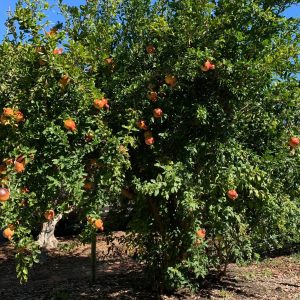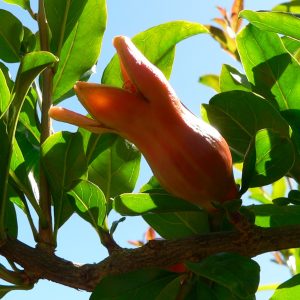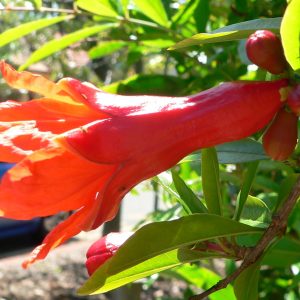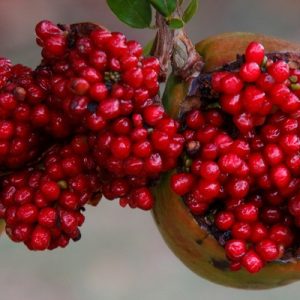Punica granatum
Pomegranate
Origin
Iran to North India.
Climate
The pomegranate grows well in areas with cold winters and a hot, dry summer and autumn. It will tolerate temperatures below freezing and also high temperatures, although fruit may be subject to sunburn. The tree has some drought tolerance and good tolerance for salt.
Plant Description
The pomegranate is deciduous. It is grown as a small tree or bush 3 to 4 m high, but can reach 6 m high. Leaves are small and elongated and the shoots are slightly spiky.
Relatives
There was only one other species in the genus, the Socotra pomegranate (protopunica) but this has now been reassigned to the Lythraceae Family, which includes loosestrife, henna and crape myrtle.
Soils
Pomegranates can be grown in a wide range of soils providing these are well drained and not acidic. Water requirements are moderate – up to 800 mm per year. The pomegranate has good tolerance to salty water.
Propagation
Varieties are mainly propagated in July from 20-30cm long hardwood cuttings of one year old wood. Seedlings will probably give poor results.
Cultivars
There are many named varieties. Wonderful is the traditional main variety in Australia and the USA. Gulosha Rosavaya and Gulosha Azerbaijani have larger arils and better eating quality, with a good sweet-sour balance. Elche is also available, but skin colour is poor.
Flowering and Pollination
Pomegranate inflorescences borne in late spring on new wood are near sessile and andromonoecious, with either one terminal flower or also with 2-4 lateral flowers below. Unopened buds normally have an orange-red fused calyx. The inferior ovary has a central style surrounded by numerous stamens attached to the interior of the calyx, with red filaments and yellow anthers. All flowers are hermaphrodite but some are functionally male with degenerate pistils; the proportion of males can be up to 70% depending on cultivar and the extent of adverse environmental conditions. Flowers are self- or cross-pollinated, usually by bees and other insects. Cross pollination improves fruit quality and yield, and fruit size is correlated with seed number. Some cvs set fruit parthenocarpically, where pollination is required for fruit set but the seeds are soft and embryos non-viable.
Cultivation
Good watering is needed during fruit development.
Wind Tolerance
They are reasonably tolerant to wind and storms
Pruning
For the first three years, select 3 to 4 main branches and tip prune to increase the number of new shoots. After annual harvest from 3 years onwards, pruning involves skirting, removal of dead branches and water sprouts, maintenance of light penetration, promotion of annual flower bud formation and ease of harvesting. Remove suckers from the base of the tree.
The Fruit
The fruit is a berry, 6 to 12 cm in diameter with a leathery, red, husk. It contains many seeds which are surrounded by soft, juicy, red arils which are edible. The interior is separated by pithy, membranous walls. The fruit has a permanent, prominent, calyx at its distal end. Some varieties have white, pink or purple arils. The juice surrounding the seeds has about 15% total soluble solids. Commercially prepared juices have 3 times the antioxidant levels of red wine or green tea.
Fruit Production and Harvesting
Trees take 3 years to commence bearing. Clip the fruit from March to June in Perth. Split fruit, associated with a rapid increase in hydration during maturation, can also be harvested and have good fruit quality. Yields are moderate. Fruit does not ripen off the tree (non-climacteric).
Fruit Uses
Fruit is usually eaten fresh or made into juice, but also has culinary uses. The arils have excellent quality with an exquisite after-taste. The soft seeds may also be eaten. It may be laborious and tedious to extract the arils from the pithy partitions which are bitter, but practice makes perfect. The pomegranate is very useful in fruit salads, and fruit have a good storage life at 4°C.
Pests and Diseases
Twisting of the leaves and terminal shoots may be due to aphids feeding. Fruit rots can be damaging to parts of the fruit, especially with the Gulosha varieties.
Comments
The pomegranate is only a small commercial crop in Western Australia. However, it’s a good one for Perth home gardens although separating the edible arils can be messy. The pomegranate is also a hardy ornamental with attractive autumn foliage. Pomegranates grow well from Carnarvon to the South Coast of Western Australia.
More Information
Pomegranate, the legendary ‘fruit of paradise’
There is archaeological evidence showing pomegranates have been cultivated as a source of food and medicines in the Middle East for millennia. It’s so highly valued in some cultures it features in their religious history and has been called the ‘fruit of paradise’, the ‘fruit of love’ because of their many seeds representing fertility, and more recently ‘nature’s power fruit’. In traditional folk remedies it’s been used for just about everything – eliminating parasites, improving libido and skin problems, relief of menopausal symptoms, as an antipyretic, contraceptive, vermifuge and anti-helminthic, and to treat ulcers, snake bites, diabetes, rheumatoid arthritis, mental diseases, cardiovascular, respiratory, fertility and hormonal problems, diarrhoea, acidosis, dysentery, haemorrhage and microbial infections.
In many impoverished countries with limited access to modern medicines and vaccines, it still finds use in these various treatments. Historically in Western countries it’s really not been more than a curiosity fruit, valued mainly as an ornamental tree with beautiful glossy green foliage and bright red flowers, and for use of the fruit as an adornment in a dining room setting.
As often happens in the development of world-wide interest in nutritional and medicinal fruit qualities, the early scientific work came from indigenous areas where pomegranates are strongly embedded in local cuisines and lifestyles. These isolated studies reported a range of positive features mainly centred on polyphenolic (PP) antioxidant activity. For example, one study found that pomegranate juice (PJ) had more PPs than juices from (in decreasing order) red plum, grape, cranberry, kiwi fruit, orange, grapefruit, apple, pineapple, pear and peach, with the range from PJ to peach being 5-fold. Others found antioxidant activity in PJ was 3 times that of red wine and green tea, and in another it was greater than that in 22 other commonly eaten fruits. These reports then led to more widespread interest from the global research community that has grown remarkably in the last 20 years. The increase in research can be gauged from a literature search conducted in November 2012 for published studies on pomegranates that retrieved 677 studies, of which 619 had been published in the last 10 years and 425 in the last 5. The usual approach to addressing nutritional questions on foods is to begin with laboratory work, as compared to human studies, it’s much easier and faster to perform without exorbitant costs, has fewer ethical and logistical restraints and concerns over possible toxicities, and can suggest future promising lines of investigation and appropriate dosage for desired effects together with some understanding of possible mechanisms. Identification of the important and different active chemicals present with suitably specific and sensitive assays, their bioavailability, metabolism and excretion also needs study in the lab. This process has been largely followed with pomegranate fruit, and while many favourable results have been forthcoming in the last decade there have so far been relatively few randomised clinical trials at doses that can reasonably be expected to be consumed, which would allow assessment of cause and health effects in humans.
As an aside, all this research activity has led to pomegranates becoming quite trendy in developed countries of late, with considerable marketing hype on their ability to prevent many of the chronic diseases currently causing so much concern. The food processing industry has jumped on the bandwagon, producing all manner of PJ extracts and supplements for the health conscious, at specialty prices of course. If you believe pomegranates are good for you and wish to regularly include them in your diet, a 2009 study emphasises how you might be better off growing your own or at least purchasing the whole fruit rather than more convenient juice, tablet or capsule forms. One of the metabolites of PJ is the PP ellagic acid, and it’s commonly been used to standardise PP concentration in these extract products as it’s easier to assay than many others. In this 2009 study they found that only 5 out of 27 commerciallyavailable products in the US had the natural distribution of PPs, 17 had been adulterated with added cheaper sources of ellagic acid, and 5 had almost no antioxidant activity at all as a result of how they were processed. Ellagic acid is an antioxidant, but these compounds almost always exert their effects in synergistic interactions with the many other PPs in whole fruit rather than being effective alone, so inadequate or improper quality control on these supplements may mean they have very little value.
The following review of the published literature by a German and Swiss group (Phytotherapy (2015), 29: 501–508) considered just one area where pomegranates are purported to have beneficial health effects, namely cardiovascular disease, still the biggest cause of morbidity and mortality world-wide. It was concluded that the evidence available as of 2015 was not sufficiently strong to be convincing, but they acknowledged with all the studies currently in progress this evaluation could become more positive in future. It illustrates the very large gap between promising lower level scientific studies (laboratory, animal and epidemiological) and those that are relevant and properly controlled in the realistic human setting, let alone those that rely solely on centuries-old traditional practices and beliefs based on essentially zero real knowledge.
This study attempts a critical evaluation of the clinical evidence behind the use of dietary pomegranate preparations in the prevention and treatment of cardiovascular diseases. A search of PubMed on August 10, 2014 identified 228 references, which yielded extractable data from 24 clinical studies of pomegranate preparations. Hand searching identified two further studies. The quality of the studies and evidence of effectiveness of pomegranate were assessed by an established set of conventional criteria. Overall, the study quality was poor. Even in the best studies, indications of benefit did not reach the conventional levels of statistical significance. The only study with a definitive design had a biochemical rather than a clinical endpoint: it showed the expected difference in blood concentrations of myeloperoxidase (a marker for cardiovascular mortality risk) after a single dose of either pomegranate or placebo. Only 10 of the 26 studies provided HPLC data (a sensitive and specific assay technique) on the amounts of co-active ingredients in the preparations that were consumed by the subjects. If pomegranate has a role in the prevention and treatment of cardiovascular diseases, there is a pressing need for dose-finding and long-term confirmatory studies. The ultimate endpoint for definitive studies would be mortality, but reductions in blood pressure or demonstrable decreases in atherosclerotic plaques would be useful surrogates. Sample sizes for various assumptions are provided. Future studies need to prove the clinical benefit.
So we have a cautionary tale here. Enjoy the fruit if flavour, good storage properties, taste, availability etc make them appealing to you, but keep your feet on the ground regarding hyped-up claims about their magical qualities. Buy whole fruit or grow your own if this feeling is strong enough instead of relying on costly and maybe dubious extracts. Pomegranates have a place in a varied diet by providing their own mix of valuable nutrients, not above all else but together with other delicious fruits. And let’s see what is scientifically established for them in coming years regarding their promise (eg with prostate cancer) in being able to make a distinct contribution to human health and well-being.



